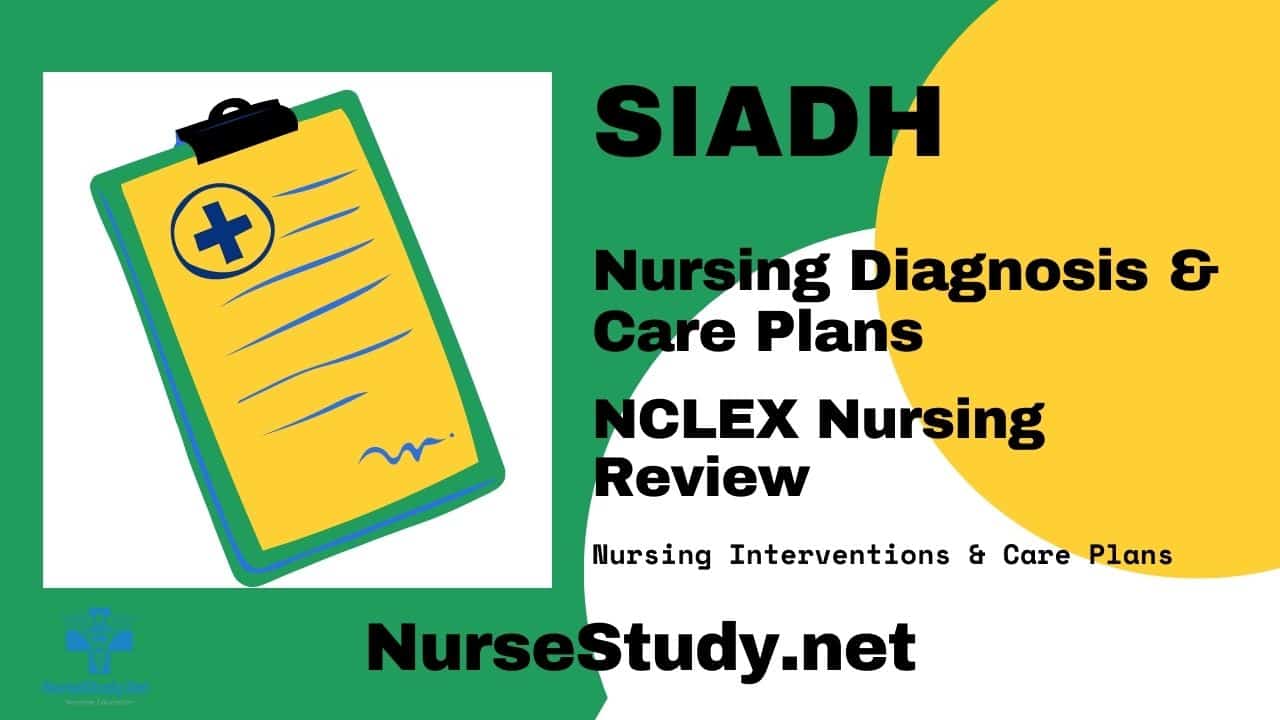Syndrome of Inappropriate Antidiuretic Hormone (SIADH) is a complex endocrine disorder requiring careful nursing assessment and intervention. This comprehensive guide explores the essential nursing diagnoses, care plans, and evidence-based interventions for managing patients with SIADH.
Understanding SIADH
SIADH occurs when the body produces excessive amounts of antidiuretic hormone (ADH), leading to water retention and dilutional hyponatremia. This condition disrupts the body’s normal fluid and electrolyte balance, potentially causing serious complications if not properly managed.
Common Causes of SIADH:
- Central nervous system disorders
- Malignancies, particularly small cell lung cancer
- Medications (antidepressants, antipsychotics)
- Post-surgical states
- Pulmonary diseases
- Head trauma
- Severe infections
Clinical Manifestations:
- Headache
- Confusion
- Muscle weakness
- Seizures
- Nausea and vomiting
- Decreased urine output
- Mental status changes
- Balance disturbances
Nursing Assessment
The comprehensive nursing assessment for SIADH patients includes:
- Neurological status monitoring
- Fluid balance evaluation
- Vital signs tracking
- Mental status assessment
- Daily weight measurements
- Intake and output monitoring
- Electrolyte level tracking
Nursing Care Plans for SIADH
1. Risk for Fluid Volume Excess
Nursing Diagnosis: Risk for Fluid Volume Excess related to compromised regulatory mechanism and excessive ADH secretion.
Related Factors:
- Impaired water excretion
- Excessive ADH production
- Altered regulatory mechanisms
- Medication side effects
Nursing Interventions and Rationales:
- Implement strict fluid restriction
Rationale: Prevents further fluid retention and sodium dilution - Monitor daily weights and trends
Rationale: Early detection of fluid retention - Assess for edema and fluid overload signs
Rationale: Identifies complications early - Document accurate intake and output
Rationale: Ensures precise fluid balance monitoring
Desired Outcomes:
- The patient maintains a stable weight
- Demonstrates balanced intake and output
- Shows no signs of fluid overload
- Maintains sodium levels within normal range
2. Acute Confusion
Nursing Diagnosis: Acute Confusion related to hyponatremia and cerebral edema.
Related Factors:
- Electrolyte imbalance
- Cerebral edema
- Altered tissue perfusion
- Metabolic changes
Nursing Interventions and Rationales:
- Perform frequent neurological assessments
Rationale: Detects early changes in mental status - Monitor sodium correction rate
Rationale: Prevents central pontine myelinolysis - Maintain safe environment
Rationale: Prevents injury during confusion - Document mental status changes
Rationale: Tracks progression of symptoms
Desired Outcomes:
- Patient maintains a normal consciousness level
- Demonstrates improved cognitive function
- Shows no signs of neurological deterioration
3. Risk for Injury
Nursing Diagnosis: Risk for Injury related to altered mental status and weakness.
Related Factors:
- Muscle weakness
- Altered consciousness
- Balance disturbances
- Seizure potential
Nursing Interventions and Rationales:
- Implement fall precautions
Rationale: Prevents falls and injuries - Assist with ambulation
Rationale: Ensures patient safety during mobility - Keep the bed in a low position
Rationale: Minimizes injury risk - Use seizure precautions when indicated
Rationale: Protects patient during potential seizures
Desired Outcomes:
- The patient remains free from injury
- Demonstrates safe mobility
- Maintains physical safety
4. Deficient Knowledge
Nursing Diagnosis: Deficient Knowledge related to lack of information about SIADH management.
Related Factors:
- Complex medical condition
- Unfamiliarity with fluid restrictions
- Limited understanding of medication regimen
- New diagnosis
Nursing Interventions and Rationales:
- Provide education about fluid restrictions
Rationale: Ensures patient compliance - Explain medication purpose and side effects
Rationale: Improves medication adherence - Teach symptoms requiring medical attention
Rationale: Promotes early intervention - Include family in education
Rationale: Enhances support system understanding
Desired Outcomes:
- Patient verbalizes understanding of SIADH
- Demonstrates compliance with treatment
- Identifies warning signs requiring intervention
5. Imbalanced Nutrition: Less than Body Requirements
Nursing Diagnosis: Imbalanced Nutrition: Less than Body Requirements related to nausea and fluid restrictions.
Related Factors:
- Nausea and vomiting
- Restricted fluid intake
- Altered taste perception
- Poor appetite
Nursing Interventions and Rationales:
- Monitor nutritional intake
Rationale: Ensures adequate nutrition - Administer antiemetics as ordered
Rationale: Controls nausea and vomiting - Provide small, frequent meals
Rationale: Improves nutritional intake - Monitor weight trends
Rationale: Tracks nutritional status
Desired Outcomes:
- The patient maintains stable weight
- Demonstrates adequate nutritional intake
- Shows improved appetite
References
- Ackley, B. J., Ladwig, G. B., Makic, M. B., Martinez-Kratz, M. R., & Zanotti, M. (2023). Nursing diagnoses handbook: An evidence-based guide to planning care. St. Louis, MO: Elsevier.
- Ezzone SA. SIADH. Clin J Oncol Nurs. 1999 Oct;3(4):187-8. PMID: 10703326.
- Grant P, Ayuk J, Bouloux PM, Cohen M, Cranston I, Murray RD, Rees A, Thatcher N, Grossman A. The diagnosis and management of inpatient hyponatraemia and SIADH. Eur J Clin Invest. 2015 Aug;45(8):888-94. doi: 10.1111/eci.12465. Epub 2015 Jun 28. PMID: 25995119; PMCID: PMC4744950.
- Martínez González, Á., Valle Feijoo, L., De la Fuente Aguado, J., & González Nunes, M. (2024). Treatment of hyponatremia due to SIADH with oral urea. Medicina ClíNica (English Edition), 162(6), 303-304. https://doi.org/10.1016/j.medcle.2023.10.019
- Peri A, Grohé C, Berardi R, Runkle I. SIADH: differential diagnosis and clinical management. Endocrine. 2017 Jan;55(1):311-319. doi: 10.1007/s12020-016-0936-3. Epub 2016 Mar 30. PMID: 27025948.
- Silvestri, L. A. (2023). Saunders comprehensive review for the NCLEX-RN examination. St. Louis, MO: Elsevier.
